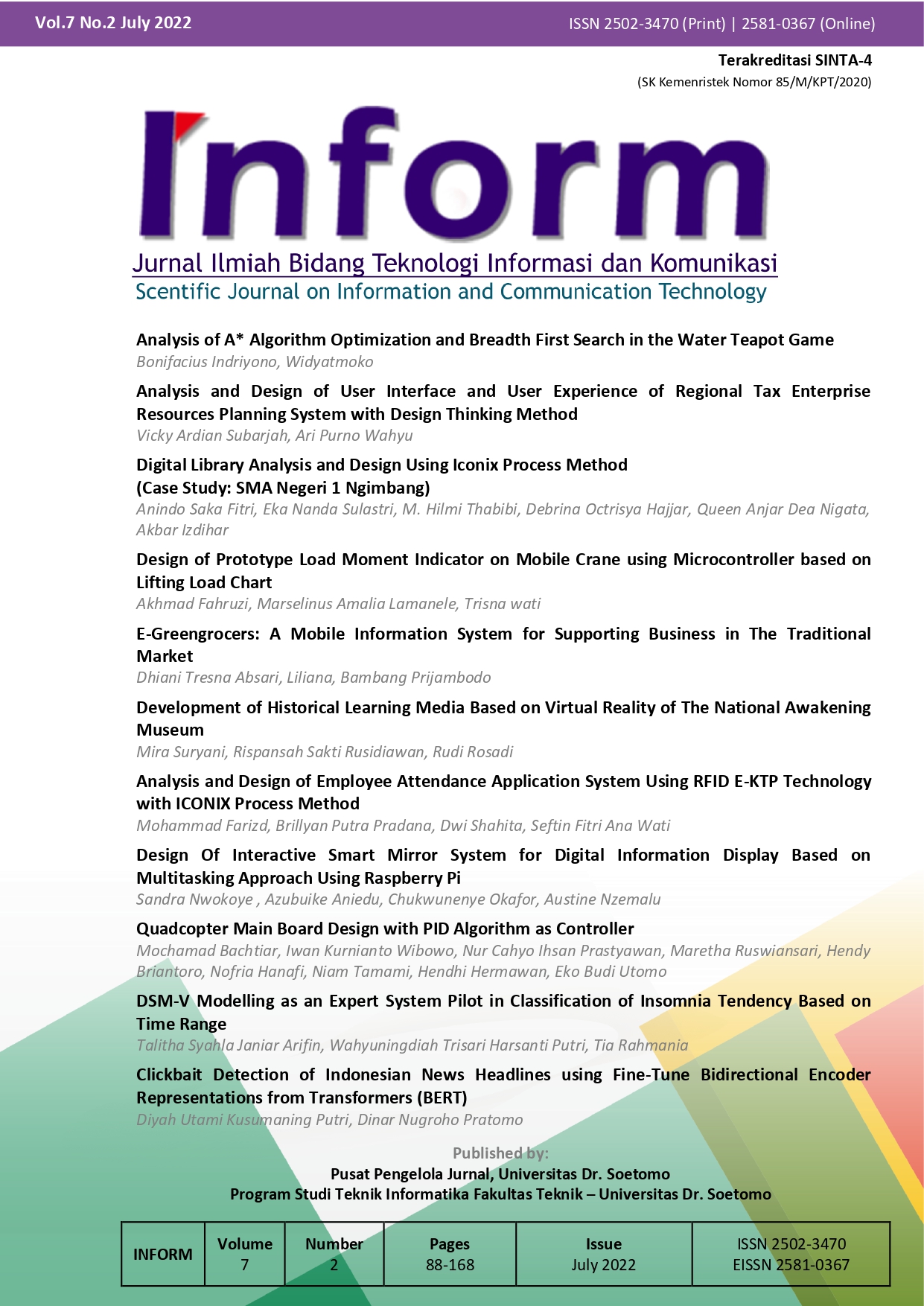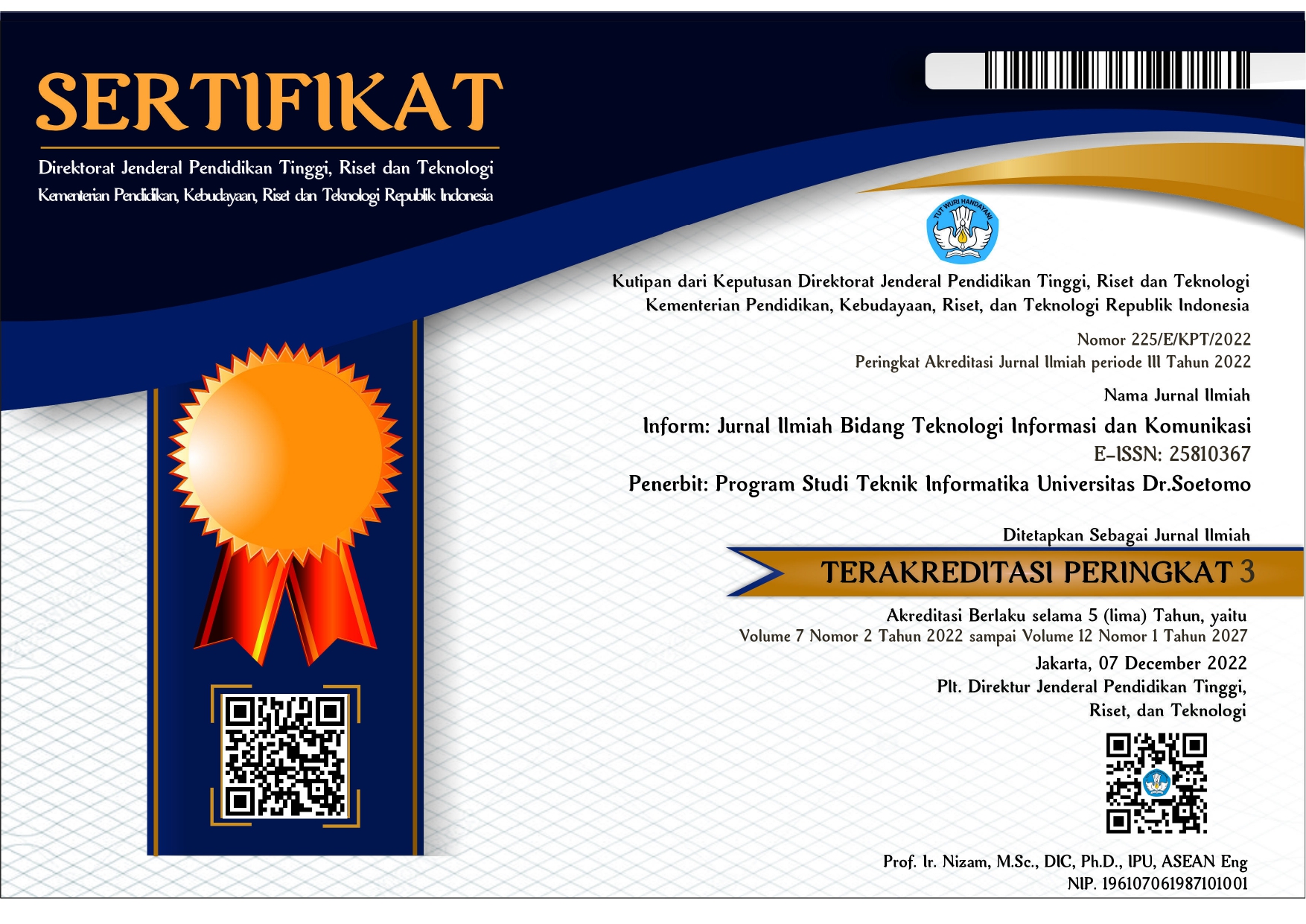Development of Historical Learning Media Based on Virtual Reality of The National Awakening Museum
 Abstract views: 516
,
Abstract views: 516
,
 PDF downloads: 432
PDF downloads: 432
Abstract
In history learning, visits to locations such as museums or other historical places in the pandemic Covid-19 situation are minimal. However, learning activities must be continued, and the existing conventional learning media in the pandemic scenario are deemed less to provide the experience. Based on previous learning experiences, an obligation to transfer knowledge from museum managers, and technological developments related to virtual reality, supports an idea to develop a museum national awakening virtual reality. This VR application is expected to become an alternative historical learning medium. This study aims to create a museum national awakening VR based on 360-degree images of the museum location. The multimedia development life cycle (MDLC) is chosen as the method used in developing the proposed VR application. The procedure consists of six steps: defining the concept based on on-site observation and interviews with the manager, creating the design, collecting the material, assembling materials and interactions with code, testing the proposed application, and distributing the system. The proposed virtual tour application has been successfully developed following the methodological principles chosen. It is also supported by a series of observations in the field using a cognitive walkthrough approach. The application was then reviewed by five experts: historians, multimedia, and learning experts. The location detailing is perfectly captured, including all the objects shown in each museum room. The quiz feature also strengthens the VR application as the learning medium, but it needs to be developed further in the evaluation section.
References
S. Seyfi, C. M. Hall, and B. Shabani, “COVID-19 and international travel restrictions: the geopolitics of health and tourism,” Tour. Geogr., vol. 0, no. 0, pp. 1–17, 2020.
E. Sudiapermana and Muslikhah, “The Challenges of Online Learning in Covid-19 Pandemic Era,” vol. 510, no. Icosaps, pp. 64–74, 2020.
R. of I. Ministry of Education and Culture, “Buku panduan museum kebangkitan nasional,” 2017.
M. J. Kim and C. M. Hall, “A hedonic motivation model in virtual reality tourism: Comparing visitors and non-visitors,” Int. J. Inf. Manage., vol. 46, no. March, pp. 236–249, 2019.
A. M. Martínez-Graña, J. L. Goy, and C. A. Cimarra, “A virtual tour of geological heritage: Valourising geodiversity using google earth and QR code,” Comput. Geosci., vol. 61, pp. 83–93, 2013.
P. Gutowski and Z. Klos-Adamkiewicz, “Development of e-service virtual museum tours in Poland during the SARS-CoV-2 pandemic,” Procedia Comput. Sci., vol. 176, pp. 2375–2383, 2020.
M. K. Bekele, “Walkable Mixed Reality Map as interaction interface for Virtual Heritage,” Digit. Appl. Archaeol. Cult. Herit., vol. 15, p. e00127, 2019.
Y. Zhou, J. Chen, and M. Wang, “A meta-analytic review on incorporating virtual and augmented reality in museum learning,” Educ. Res. Rev., vol. 36, no. November 2021, p. 100454, 2022.
W. Tabone, “The Effectiveness of an Augmented Reality Guiding System in an Art Museum,” in Rediscovering Heritage Through Technology: A Collection of Innovative Research Case Studies That Are Reworking The Way We Experience Heritage, D. Seychell and A. Dingli, Eds. Cham: Springer International Publishing, 2020, pp. 197–214.
H. Lee, T. H. Jung, M. C. tom Dieck, and N. Chung, “Experiencing immersive virtual reality in museums,” Inf. Manag., vol. 57, no. 5, p. 103229, 2020.
M. Park, H. Oh, and J. Park, “Measuring the Experience Economy of Film Festival Participants,” Int. J. Tour. Sci., vol. 10, no. 2, pp. 35–54, Jan. 2010.
T. Jung, M. C. tom Dieck, H. Lee, and N. Chung, “Effects of Virtual Reality and Augmented Reality on Visitor Experiences in Museum,” in Information and Communication Technologies in Tourism 2016, 2016, pp. 621–635.
J. Pallud and D. W. Straub, “Effective website design for experience-influenced environments: The case of high culture museums,” Inf. Manag., vol. 51, no. 3, pp. 359–373, 2014.
M. Carrozzino and M. Bergamasco, “Beyond virtual museums: Experiencing immersive virtual reality in real museums,” J. Cult. Herit., vol. 11, no. 4, pp. 452–458, 2010.
E. Spiers et al., “Estrangement, immersion, and the future: Designing the speculative environments of the virtual reality ‘Museum of the Future,’” Futures, vol. 138, no. May 2021, p. 102922, 2022.
M. H. MZ, “Aplikasi Rekomendasi Spot Area Wisata Berbasis Android dengan Teknik Geotag,” Inf. J. Ilm. Bid. Teknol. Inf. dan Komun., vol. 2, no. 2, pp. 6–11, 2017.
H. Armanto, G. Anthony, and P. Pickerling, “Implementation and Impact of Virtual Reality on Survival Horror Games,” Inf. J. Ilm. Bid. Teknol. Inf. dan Komun., vol. 6, no. 2, pp. 87–92, 2021.
E. A. Laksono and A. Susanto, “Mathematics Education Game Using the Finite State Machine Method to Implement Virtual Reality in Game Platformer,” Inf. J. Ilm. Bid. Teknol. Inf. dan Komun., vol. 5, no. 1, pp. 8–13, 2020.
I. L. Achmad Choiron, “Aplikasi Virtual Tour Dinamis Pada Universitas Dr. Soetomo Surabaya Berbasis Web,” Inf. J. Ilm. Bid. Teknol. Inf. dan Komun., vol. 2, no. 1, 2017.
A. C. Luther, Authoring Interactive Multimedia. USA: Academic Press Professional, Inc., 1994.
O. B. P. Mah et al., “Generating a virtual tour for the preservation of the (in)tangible cultural heritage of Tampines Chinese Temple in Singapore,” J. Cult. Herit., vol. 39, pp. 202–211, 2019.
S. Schlögl, M. E. R. Bergmann, V. Eder, M. Achleitner, and P. Evangelatos, “Google Cardboard in Social Science Research – Exploring low-cost virtual reality and its potential,” Proc. Forschungsforum der Österreichischen Fachhochschulen, no. January, pp. 814–818, 2017.
A. G. Sutcliffe and K. D. Kaur, “Evaluating the usability of virtual reality user interfaces,” Behav. Inf. Technol., vol. 19, no. 6, pp. 415–426, 2000.
K. Kabassi and E. Maravelakis, “Walkthrough evaluation of a VR museum for the physical environment,” IISA 2015 - 6th Int. Conf. Information, Intell. Syst. Appl., 2016.
P. Mealy, “Virtual Reality Design Principles: Starting Up, User Attention, and Comfort Zones,” Dummies, 2018. .
T. Yang, I. K. W. Lai, Z. Bin Fan, and Q. M. Mo, “The impact of a 360° virtual tour on the reduction of psychological stress caused by COVID-19,” Technol. Soc., vol. 64, no. December 2020, p. 101514, 2021.
O. Allal-Chérif, “Intelligent cathedrals: Using augmented reality, virtual reality, and artificial intelligence to provide an intense cultural, historical, and religious visitor experience,” Technol. Forecast. Soc. Change, vol. 178, no. January, 2022.
M. Milosz, S. Skulimowski, J. Kęsik, and J. Montusiewicz, “Virtual and interactive museum of archaeological artefacts from Afrasiyab – An ancient city on the silk road,” Digit. Appl. Archaeol. Cult. Herit., vol. 18, no. July, 2020.
J. M. Lightfoot, “Modular curriculum design using personal learning plans and reusable learning components,” Commun. IIMA, vol. 6, no. 4, pp. 65–80, 2006.
A. Sutcliffe and B. Gault, “Heuristic evaluation of virtual reality applications,” Interact. Comput., vol. 16, no. 4, pp. 831–849, 2004.
X. Deng, H. R. Unnava, and H. Lee, “‘Too true to be good?’ when virtual reality decreases interest in actual reality,” J. Bus. Res., vol. 100, no. January 2018, pp. 561–570, 2019.
K. L. Chan, K. Ichikawa, Y. Watashiba, and H. Iida, “Cloud-Based VR Gaming: Our Vision on Improving the Accessibility of VR Gaming,” Proc. - 2017 Int. Symp. Ubiquitous Virtual Reality, ISUVR 2017, pp. 24–25, 2017.
P. Abichandani, W. McIntyre, W. Fligor, and D. Lobo, “Solar Energy Education through a Cloud-Based Desktop Virtual Reality System,” IEEE Access, vol. 7, pp. 147081–147093, 2019.
Copyright (c) 2022 Mira Suryani, Rispansah Sakti Rusidiawan, Rudi Rosadi

This work is licensed under a Creative Commons Attribution-ShareAlike 4.0 International License.
Authors who publish with Inform: Jurnal Ilmiah Bidang Teknologi Informasi dan Komunikasi agree to the following terms:
-
Authors retain copyright and grant the journal right of first publication with the work simultaneously licensed under a Creative Commons Attribution License (CC BY-SA 4.0) that allows others to share the work with an acknowledgment of the work's authorship and initial publication in this journal.
-
Authors are able to enter into separate, additional contractual arrangements for the non-exclusive distribution of the journal's published version of the work (e.g., post it to an institutional repository or publish it in a book), with an acknowledgment of its initial publication in this journal.
-
Authors are permitted and encouraged to post their work online (e.g., in institutional repositories or on their website) prior to and during the submission process, as it can lead to productive exchanges, as well as earlier and greater citation of published work.













